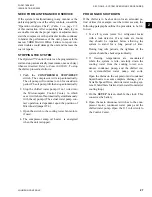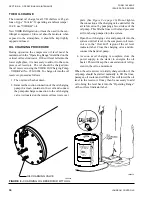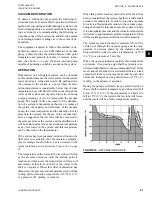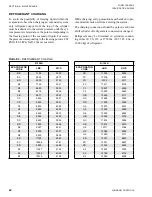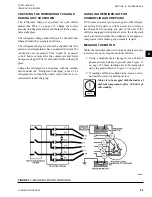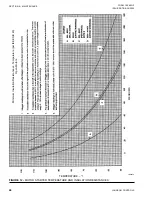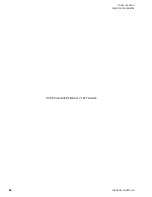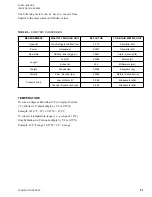
JOHNSON CONTROLS
40
FORM 160.69-O2
ISSUE DATE: 9/30/2020
SECTION 6 – MAINTENANCE
*One standard atmosphere = 14.696 Psia
= 760 mm Hg. absolute pressure at 32°F
= 29.921 inches Hg. absolute at 32°F
NOTES: PSIA = Lbs. per sq. in. gauge pressure
= Pressure above atmosphere
PSIA = Lbs. per sq. in. absolute pressure
= Sum of gauge plus atmospheric pressure
TABLE 2 -
SYSTEM PRESSURES
* GAUGE
ABSOLUTE
BOILING
TEMPERATURES OF
WATER °F
Inches Of Mercury
(HG) Below One
Standard Atmosphere
PSIA
Millimeters Of
Mercury (HG)
Microns
0
10.24"
22.05"
25.98"
27.95"
28.94"
29.53"
29.67"
29.72"
29.842"
29.882"
29.901"
29.917"
29.919"
29.9206"
29.921"
14.696
9.629
3.865
1.935
.968
.481
.192
.122
.099
.039
.019
.010
.002
.001
.0002
0
760.
500.
200.
100.
50.
25.
10.
6.3
5.
2.
1.0
.5
.1
.05
.01
0
760,000
500,000
200,000
100,000
50,000
25,000
10,000
6,300
5,000
2,000
1,000
500
100
50
10
0
212
192
151
124
101
78
52
40
35
15
+1
-11
-38
-50
-70
VACUUM TESTING
After the pressure test has been completed, the vacuum
test should be conducted as follows:
1. Connect a high capacity vacuum pump, with in-
dicator, to the system charging valve as shown in
2. Open wide all system valves. Be sure all valves to
the atmosphere are closed.
3. Operate the vacuum pump in accordance with
VACUUM DEHYDRATION
until a wet bulb
temperature of +32°F or a pressure of 5 mm Hg
is reached. See
sponding values of pressure.
4. To improve evacuation circulate hot water (not
to exceed 125°F, 51.7ºC) through the evaporator
and condenser tubes to thoroughly dehydrate the
shells. If a source of hot water is not readily avail-
able, a portable water heater should be employed.
DO NOT USE STEAM
. A suggested method is
to connect a hose between the source of hot water
under pressure and the evaporator head drain con-
nection, out the evaporator vent connection, into
the condenser head drain and out the condenser
vent. To avoid the possibility of causing leaks, the
temperature should be brought up slowly so that
the tubes and shell are heated evenly.
5. Close the system charging valve and the stop
valve between the vacuum indicator and the vac-
uum pump. Then disconnect the vacuum pump
leaving the vacuum indicator in place.
6. Hold the vacuum obtained in Step 3 in the system
for 8 hours; the slightest rise in pressure indicates
a leak or the presence of moisture, or both. If, after
24 hours the wet bulb temperature in the vacuum
indicator has not risen above 40°F (4.4°C) or a
pressure of 6.3 mm Hg, the system may be con-
sidered tight.
Be sure the vacuum indicator is valved off
while holding the system vacuum and be
sure to open the valve between the vacuum
indicator and the system when checking
the vacuum after the 8 hour period..
7. If the vacuum does not hold for 8 hours within the
limits specified in Step 6 above, the leak must be
found and repaired.
Summary of Contents for YD A
Page 8: ...JOHNSON CONTROLS 8 FORM 160 69 O2 ISSUE DATE 9 30 2020 THIS PAGE INTENTIONALLY LEFT BLANK...
Page 22: ...JOHNSON CONTROLS 22 FORM 160 69 O2 ISSUE DATE 9 30 2020 THIS PAGE INTENTIONALLY LEFT BLANK...
Page 28: ...JOHNSON CONTROLS 28 FORM 160 69 O2 ISSUE DATE 9 30 2020 THIS PAGE INTENTIONALLY LEFT BLANK...
Page 34: ...JOHNSON CONTROLS 34 FORM 160 69 O2 ISSUE DATE 9 30 2020 THIS PAGE INTENTIONALLY LEFT BLANK...
Page 48: ...JOHNSON CONTROLS 48 FORM 160 69 O2 ISSUE DATE 9 30 2020 THIS PAGE INTENTIONALLY LEFT BLANK...


